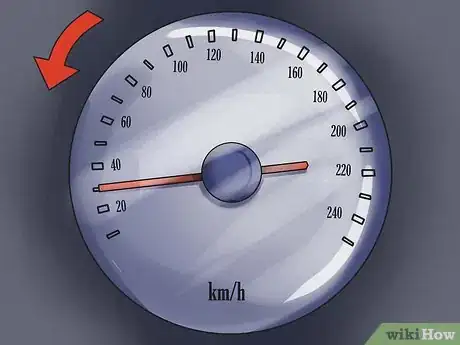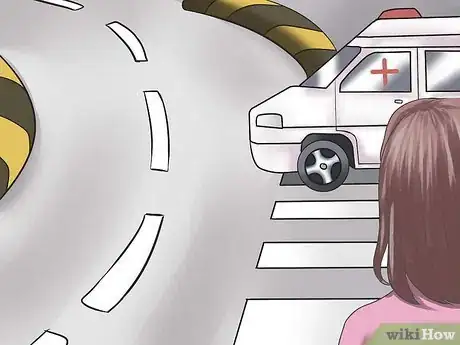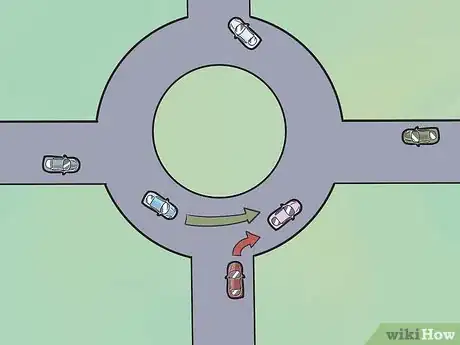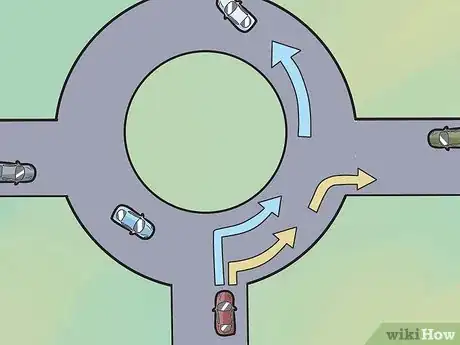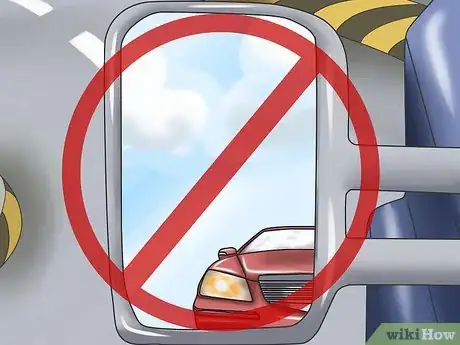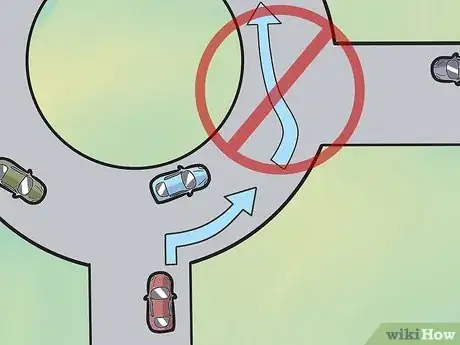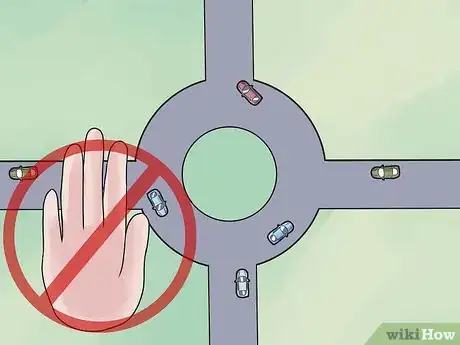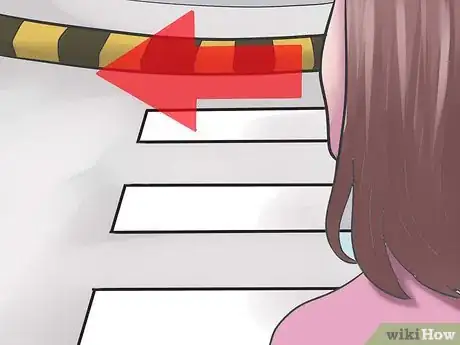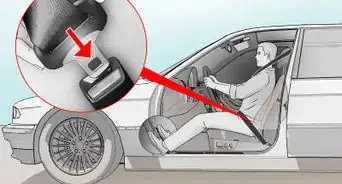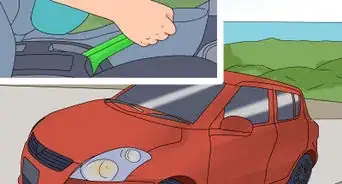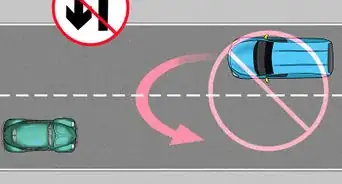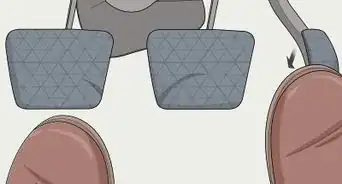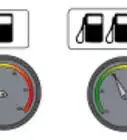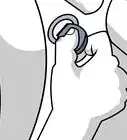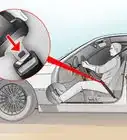This article was co-authored by Bruce Storrs. Bruce Storrs is a Driving Instructor and the President & CEO of North County School of Driving in San Marcos, California. With more than 31 years of experience, he specializes in teaching teens and adults safe driving behaviors in the classroom, online, and behind the wheel. Bruce earned a BA and MA from San Diego State University.
There are 9 references cited in this article, which can be found at the bottom of the page.
wikiHow marks an article as reader-approved once it receives enough positive feedback. This article has 11 testimonials from our readers, earning it our reader-approved status.
This article has been viewed 169,446 times.
Roundabouts are changing the way we drive. In certain parts of the world, roundabouts used to be uncommon. Now, they are increasingly being used because they ease congestion, cost less to operate, reduce accidents by roughly half, and use less energy than traditional light-operated intersections.[1] Learn how to navigate a roundabout by starting with Step 1 below.
Steps
-
1Slow down as you approach the roundabout. At this point, you should see a "Roundabout Ahead" sign followed by a "Yield" sign. The recommended speed is normally 15 - 20 mph (24 - 32 kph).[2]
-
2Look to your left before entering the roundabout and yield to any oncoming traffic. Traffic already in the roundabout has the right-of-way. Do not enter unless a safe gap is present. If there is no traffic in the roundabout, you may enter the roundabout without yielding.[3]
- Crosswalks are placed one or two car-lengths before the roundabout itself. Yield to any pedestrians who are in, or about to enter, the crosswalk.
- If a car is in the roundabout, you could look at the direction of its tires or if it has a signal, this will give you an indication whether they're turning or they're going to go straight through the roundabout.
Advertisement -
3Enter the roundabout when there is a safe gap in traffic. Maintain a low speed as you maneuver through the roundabout and proceed to your exit.[4]
-
4Engage your turn signal as you approach your desired exit. This will inform other drivers that you wish to exit the roundabout, easing confusion.[5]
-
5Yield only to pedestrians in the crosswalk or emergency vehicles when exiting a roundabout. Remember that drivers inside the roundabout have the right-of-way. Unless a pedestrian is crossing the crosswalk or an emergency vehicle, such as an ambulance, is entering or exiting the roundabout, proceed through the exit without stopping or slowing down.[6]
- If an emergency vehicle is about to enter or has already entered the roundabout, do not stop in the roundabout. Instead, exit out your original destination and only then pull over.
-
1Remember to yield to both lanes of traffic in a multi-lane roundabout.[7] If you know you'll be turning right, and hence staying in the rightmost lane, but you see an oncoming car in the left lane, wait for it to pass before entering the roundabout. Although frowned on, the car could merge into your lane just as you are entering the roundabout, causing an accident.
-
2Choose which lane to enter based on which direction you want to exit. In multi-lane roundabouts, which usually have three or more possible exits, the lane you choose to drive in is dictated by the kind of turn you want to make:[8]
- Occupy the left lane if you decide to turn left, make a U-turn, or go straight.
- Occupy the right lane if you decide to turn right or go straight.
- Look for signs indicating the allowed movements for each lane. These signs are usually located above or alongside the road and/or arrows painted on the road itself.
-
3Never drive next to, or attempt to pass, a large vehicle or truck on a multi-lane roundabout. Large trucks have a larger turning radius, making them one of the more dangerous obstacles in a roundabout. Always give them ample room to turn by staying behind them a bit more than you ordinarily would with passenger vehicles.[9]
-
4Stay in your lane at all times. Never change lanes while in a multi-lane roundabout.[10]
-
1Do not ever stop in the middle of a roundabout. A roundabout is like an intersection, through which traffic is continuously flowing. Stopping in the middle of a roundabout will cause congestion and increase the likelihood of an accident.[11]
-
2Navigate the roundabout safely as a cyclist. If you are cycling through a roundabout, you have two options:[12]
- Enter the roundabout as if you were a vehicle. Remain centered in your lane to be most visible and avoid being cut off by other vehicles.
- If you are uncomfortable riding your bicycle through the roundabout, exit the roadway and use the crosswalks.
-
3Navigate the roundabout as a pedestrian. If you wish to cross the roundabout as a pedestrian, follow these steps:[13]
- Look to your left and cross when there is a safe gap in traffic.
- Stop when you reach the splitter island.
- Look to your right and cross when there is a safe gap in traffic.
Expert Q&A
-
QuestionWhich way do roundabouts go in the UK?
 Bruce StorrsBruce Storrs is a Driving Instructor and the President & CEO of North County School of Driving in San Marcos, California. With more than 31 years of experience, he specializes in teaching teens and adults safe driving behaviors in the classroom, online, and behind the wheel. Bruce earned a BA and MA from San Diego State University.
Bruce StorrsBruce Storrs is a Driving Instructor and the President & CEO of North County School of Driving in San Marcos, California. With more than 31 years of experience, he specializes in teaching teens and adults safe driving behaviors in the classroom, online, and behind the wheel. Bruce earned a BA and MA from San Diego State University.
Driving Instructor If you're driving a car in England, the steering wheel is probably going to be on the opposite side of the vehicle when compared to cars in the US. So you would have to be really sharp, because everything is turned around. That's a huge concern. So when you go to make your turns just out of a habit, be mindful to not turn into the lane of oncoming traffic.
If you're driving a car in England, the steering wheel is probably going to be on the opposite side of the vehicle when compared to cars in the US. So you would have to be really sharp, because everything is turned around. That's a huge concern. So when you go to make your turns just out of a habit, be mindful to not turn into the lane of oncoming traffic. -
QuestionIf I am on the inside lane because I planned to turn left, but there is a rule to not ever change lanes, how do I get into the right lane to exit?
 Community AnswerThat instruction (no lane changes) is misleading. You should cautiously merge, as required, to only exit in an authorized lane.
Community AnswerThat instruction (no lane changes) is misleading. You should cautiously merge, as required, to only exit in an authorized lane. -
QuestionDo I have to signal before entering or exiting the roundabout?
 Community AnswerIn most countries, you have to signal right (left in countries that drive on the left) when exiting the roundabout. It is also recommended to signal when you are entering the roundabout, however, it is not required. When signalling to enter in a normal roundabout, you should signal right if you are going to the first exit, left if you are going to the third exit, and nothing if you are going straight ahead.
Community AnswerIn most countries, you have to signal right (left in countries that drive on the left) when exiting the roundabout. It is also recommended to signal when you are entering the roundabout, however, it is not required. When signalling to enter in a normal roundabout, you should signal right if you are going to the first exit, left if you are going to the third exit, and nothing if you are going straight ahead.
Warnings
- Do not turn left from the right lane! This is one of the most common causes of accidents in roundabouts. In doing so, you may collide with a vehicle in the left lane that is going straight. This same rule applies to other types of intersections.⧼thumbs_response⧽
References
- ↑ https://wsdot.wa.gov/travel/traffic-safety-methods/roundabouts
- ↑ https://www.wsdot.wa.gov/Safety/roundabouts/default.htm
- ↑ https://wsdot.wa.gov/travel/traffic-safety-methods/roundabouts
- ↑ https://www.andersen.af.mil/Portals/43/Documents/Navigating%20a%20Roundabout.pdf
- ↑ https://www.andersen.af.mil/Portals/43/Documents/Navigating%20a%20Roundabout.pdf
- ↑ https://www.andersen.af.mil/Portals/43/Documents/Navigating%20a%20Roundabout.pdf
- ↑ http://www.fhwa.dot.gov/publications/research/safety/00067/00067.pdf
- ↑ https://www.dot.state.mn.us/roundabouts/navigating.html
- ↑ https://www.dot.state.mn.us/roundabouts/multilane.html
About This Article
To navigate a single-lane roundabout, slow down as you enter it so you can yield to oncoming traffic if needed. Once there is a safe gap in traffic, turn right into the roundabout. Continue driving in the circle until you approach your exit, then engage your turn signal so people in the cars around you will know you’re exiting. As you exit, make sure to yield to any pedestrians crossing the crosswalk or emergency vehicles entering or exiting the roundabout. For tips on how to cross a roundabout as a pedestrian, read on!
